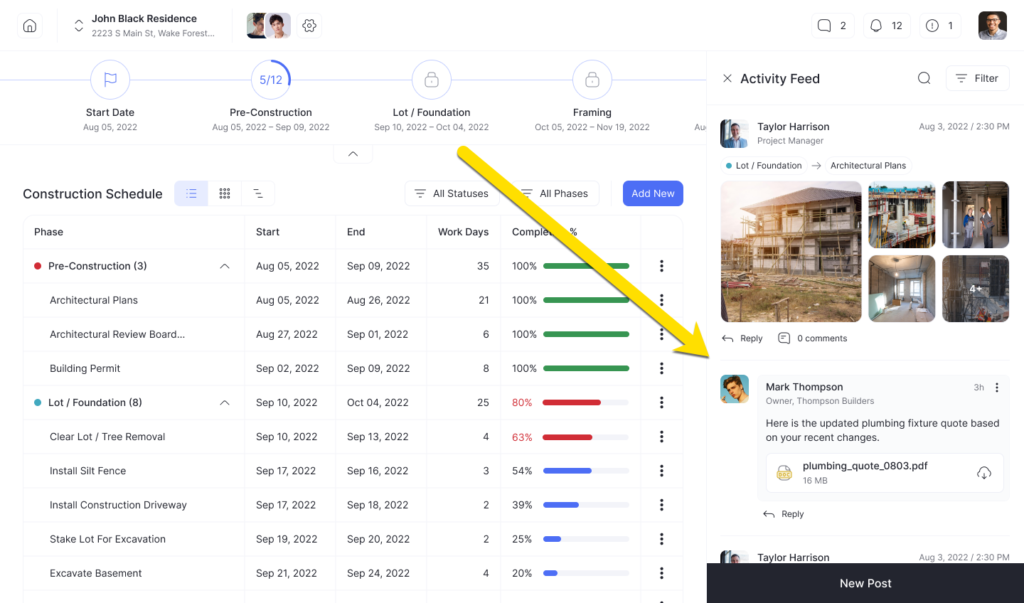The construction industry is rife with challenges, and one that often stands out is the waiting period associated with obtaining the necessary building permits.
Permit delays can range from bureaucratic red tape, local zoning issues, to environmental concerns.
For clients, especially those unfamiliar with the intricacies of the construction world, this can lead to mounting frustration and concerns about project timelines.
Takeaways:
- Educate early and often: Providing clients with a comprehensive understanding of the permitting process and potential delays can alleviate anxiety and set realistic expectations from the onset.
- Communication is paramount: Whether there are significant updates or minor developments, keeping the client informed through regular communication ensures trust and transparency throughout the project.
- Engagement Alleviates Frustration: Keeping clients actively involved in various aspects of the project during permit waiting periods ensures they feel progress is still being made. BuilderPad is a construction management software that can help you set up an effective communication management and engagement strategy with your clients.
- Advocacy Builds Trust: Demonstrating a proactive approach, such as directly liaising with authorities to expedite processes, can showcase commitment and foster stronger client relationships.
Here’s how construction professionals can effectively manage their clients’ expectations during these inevitable permit delays.
1. Education is Key

Before embarking on any project, educate your clients about the permitting process.
Offer them a realistic understanding of how long it typically takes in their municipality, the steps involved, and the potential hurdles that might arise. Knowledge often diminishes anxiety.
2. Transparent Communication
Always keep the lines of communication open. If there’s a delay, let your client know immediately.
Explain the reasons for the hold-up, whether it’s a backlog at the city’s permit office or additional documentation that’s required.
BuilderPad’s communication tools allow you to keep your client updated on everything that is going on with your project.

3. Factor in Buffer Time
When providing project timelines, always include a buffer for potential permit delays.
This not only sets realistic expectations but can also come as a pleasant surprise if the permits are secured earlier than anticipated.
4. Keep Them Engaged

During the waiting period, maintain your client’s engagement with the project.
This could be through design discussions, material selection, or planning the subsequent phases.
Keeping them involved assures them that progress is still being made, even if it’s behind the scenes.
5. Provide Regular Updates

Even if there’s no significant movement on the permit front, regular updates are crucial.
A brief email or phone call can reassure your client that they’re in the loop and that the delay isn’t due to any oversight on your part.
6. Leverage Technology

Today, many municipalities offer online tracking for permit applications.
Guide your client on how they can check the status themselves if they wish. This not only grants them autonomy but also reinforces transparency.
7. Anticipate Concerns

It’s beneficial to anticipate and address potential client concerns before they voice them.
If you sense growing impatience, consider discussing alternative solutions or contingencies, even if they’re only temporary.
8. Offer Reassurance
Remember that for many clients, this might be their first construction project. They might not only be anxious about the permit delays but also the financial implications, especially if they’re paying for rentals or other associated costs.
Reassure them by explaining the long-term benefits of waiting for the necessary permits, such as ensuring safety and adhering to legal guidelines.
9. Advocate on Their Behalf
Sometimes, it might be possible to expedite the process by liaising directly with the authorities or seeking the help of a local official.
Showing your client that you’re actively advocating for them can go a long way in building trust.
10. Highlight Past Successes
Share stories or case studies of past projects that experienced similar delays but eventually turned out successful.
This can provide your clients with a broader perspective and instill confidence in your capabilities.
In conclusion, permit delays, while frustrating, are an inherent part of the construction landscape.
By proactively managing expectations, maintaining transparent communication, and engaging clients throughout the wait, construction professionals can transform these delays into opportunities for deepening client trust and cementing long-term relationships.







